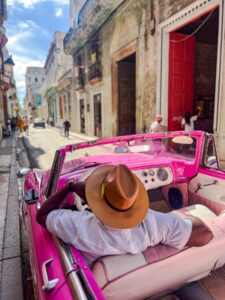
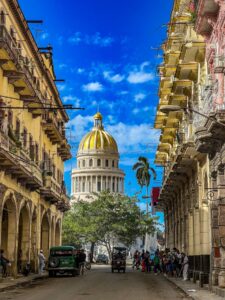

Quick guide / Overview:
- Bring enough cash to cover your entire holiday
- Book accommodation at least for the first couple of nights in advance (if you want to stay in a casa particular most people use Airbnb). You need at least one accommodation address for your D’viajero form (see below).
- Get your visa well in advance. Most nationalities can get an eVisa here: https://evisacuba.cu/ (official site) or here https://www.cubavisa.uk/. eVisas are usually approved within 48 hours. Check if you can get an eVisa here: https://en.wikipedia.org/wiki/Visa_policy_of_Cuba.
- Before your visit to Cuba fill out the electronic advance information form here: https://dviajeros.mitrans.gob.cu/inicio . Your airline will most likely request this before your check-in. (I was not allowed to fill it out until 2 days before my flight to Cuba.)
- Get a VPN (Proton VPN is free, no hassle and works well)
- Get an eSim (GigSky) in advance or get a local SIM-card when you arrive
- Take colectivos – not busses (and pray they are not driving too fast..more below)
- Prepare to eat a lot of lobster


Should I go?
Absolutely. Cuba is a paradise for travel photography, for music and culture with warm-hearted people. Most people have a great holiday – however there are a few issues to consider – pls see below.
Should I go if I am an inexperienced traveler?
Cuba is not easy. So maybe start with somewhere else if you are not used to individual travel and don’t speak Spanish.
When to go?
You can go year-round. Most people prefer winter (November to April) when it is dryer and cooler. High-season used to be January to March. Presently (Spring 2025) and unfortunately there is very few tourists in Cuba – also in the high season.
Is Cuba cheap?
Yes and no. If you travel around with Viazul busses (typically 10-20 USD for 2-4 hours of travel) or colectivos (typically 25 USD for 2-3 hours door-to-door travel), stay in Airbnb (typically 10-30 USD pr night) and eat at local pizza restaurants (Pizza 500 CUP = 1,5 USD, Beer 250 CUP = 0,75 USD) then Cuba is relatively cheap.
 However, if you want to eat at restaurants most people spend a daily 5-8 USD breakfast. 15 USD lunch, 20-25 USD dinner. Renting cars is expensive and gas is scarce. Cuba has almost no stores, supermarkets etc with goods on the shelves. I was unable to find fresh milk for sale anywhere during four weeks of travel.
However, if you want to eat at restaurants most people spend a daily 5-8 USD breakfast. 15 USD lunch, 20-25 USD dinner. Renting cars is expensive and gas is scarce. Cuba has almost no stores, supermarkets etc with goods on the shelves. I was unable to find fresh milk for sale anywhere during four weeks of travel.
Note that only tourists and rich Cubans can afford to eat in restaurants since the average public Cuban salery is around 5-7.000 CUP = less than 20 USD pr month.
Visa
It is normally easy and quick to get an electronic visa to Cuba – see above.
D’viajero
Is an electronic advance information system (like ESTA to the US). You need to fill out your details including your visa-number (ie. You must apply for your visa first). Once approved your D’viajero generates an approval letter with a QR-code. Most likely the airline flying you to Cuba will request this approval before you can check-in on the flight. See links above.
Passport
Note that all registration is now done electronically – Cuba typically won’t stamp your physical passport (they didn’t stamp my Danish passport).
Euro or USD
As of March 2025 you will get the same amount of Cuban Pesos regardless if you change Euro or USD. Street/Casa Particular rate: 1 USD = 1 Euro = 330 Cuban Pesos (CUP).
The official rate is 1 USD = 1 Euro = 120 CUP.
ATMs
As far as I know ATMs in Cuba either do not work or they issue Cuban Pesos using the official rate 1 USD = 1 Euro = 120 Cuban Pesos (CUP) meaning you will lose almost 2/3 of your money.
Credit Card
High End resorts/restaurants/tour operators will most likely accept your Visa-card (maybe also other cards). In a month in Cuba, I brought cash only and only used my Credit Card twice – to buy the credit card only 5 USD access to Hemingways room no. 511 in Hotel Ambos Mundos and to top up my GigSky eSim.
Power / Electricity
As of spring 2025 power is erratic in Cuba especially outside of Havana. Most places in Havana Vieja and Centro Habana will still have 24 hours of power but there are different sectors even in the capital and not far from the center where you still may experience frequent power cuts.
In cities/towns outside of Havana and Varadero you may be without power from 4 – 24 hours a day (typically 12-18 hours with no power when I visited).
Many Airbnb-hosts – and most upmarket hotels – will have limited back up systems running on batteries or solar power. This will typically/maybe enable you to charge your electronics, perhaps power a fan and maybe give you some selected emergency lighting during power cuts.
Power plants in Cuba are allegedly very old. If the many power cuts are due to faulty, old systems or if someone in charge simply turns the plants off to save on diesel no one seems to know for sure.
Even though there are big problems with the power in Cuba you can still have a very nice holiday. In the day most people are outside anyway.
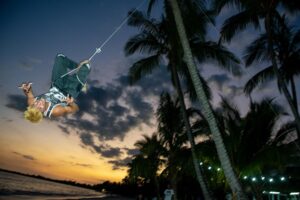

Internet
Many hotels, casa particulares, cafes and restaurants have WiFi. Unfortunately outside of Havana this WiFi rarely works. Normally WiFi does not work when there is no power. Your cheapest bet is to get a local sim-card with a data subscription.
If you (like me) don’t like changing SIM-cards get a GigSky 30 days, 3GB plan (usually 50 USD) and set your phone to use your GigSky eSim for mobile data (and set your own original SIM to receive SMS and calls). For me this worked on/off and not in all cities/towns. Often, I was only allowed to send an receive very, very limited amounts of data using this eSim. Don’t forget to download as much content as possible before you leave home.
Do I need to speak Spanish?
Yes and no. You can look for Airbnbs with English speaking families (who can help you book a colectivo to your next destination) so it can be done without speaking Spanish and especially in Havana quite a few of those who work with travelers speak English. But it is A LOT easier, more fun and more rewarding to be able to speak with the locals.
The music scene in Cuba
Is absolutely fantastic. You can hear world class singers and musicians all over the country.


Is Cuba safe?
Cuba is a very safe country for travelers. Tourists are very important to the country and the economy and therefore well looked after. However, the economic situation in the country as of spring 2025 is bad – see below – hence this may change in the future.
Economic situation
Since 2021 more than 10% of the country’s population have emigrated. The population is now 11 million people. In other words more than one million people have emigrated the last four years. Typically it’s young people who emigrate – meaning that Cubas population is getting older. Many people who do not have relatives living abroad who can send back money are struggling financially.
Travel photography
Cuba is one of the best countries in the world for travel photography. Please se more of my photos from Cuba: HERE

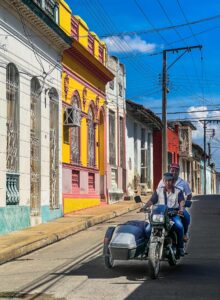

Transportation – Viazul busses versus colectivo taxis
Tickets to Viazul-busses can officially only be purchased when you are outside of Cuba. I have no idea why. Possibly you can still buy them inside Cuba if you have a VPN installed. The advantage of going with the Viazul bus is that you are guaranteed your own (entire) seat and normally Viazul drivers drive slower / more considerately than the colectivo drivers.
Disadvantages Viazul busses: Hours of departure may be day or night. Officially you have to check in 1,5 hours before departure (!). Most likely you won’t lose your reservation if your arrive ‘just’ one hour before departure though.
The advantage of the colectivos is that they take you from door to door ie. Straight from your accommodation to the next one. And they always seem to leave between 8 and 9 in the morning. Having booked a colectivo (normaly through your casa particular, your hotel or after asking around at the Viazul bus station) you will not in advance be told if it is a ‘normal’ car or a 1950’s American classic car. And you also won’t know how full it is Two people may be sharing the (wide) front seat of a classic American car – or three big guys may be sitting squeezed together in the backseat of a more modern European or Asian car. In one ride I ended up in af ’56 Chevrolet 9-seater – where we had to spend the first two hours picking up 7 other people before hitting the highway. On top of this many colectivo drivers think they are formula one drivers and drive way to fast.And they do not like to be told to slow down. I usually either say nothing, offer to pay them to slow down or tell them (in Spanish) that:
“I know they are very experienced drivers and navigate the route every day. But since my close friend died in a traffic accident last year I am now afraid of speeding.” That sometimes helps.

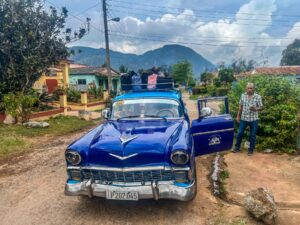
Cost of Colectivos versus Viazul busses
Colectivos and busses cost around the same – or colectivos may even work out cheaper. Example: Colectivo Havana – Vinales: 20 or 25 USD. Bus Havana – Vinales 16 USD, taxi to lodging to/from busstation approx. 15 USD, total 31 USD.
Overall, I ended up buying four Viazul bus tickets from home planning in advance to take only three colectivos during my seven trips between cities. But I ended up only using the first of my Viazul tickets (wasting around 50 USD) and taking six colectivos.
Two of my six colectivos turned out to be very old and very classic American cars. One of them broke down on the way but the driver fixed in (took only around 15 minutes). In Havana people typically pay 30-40 USD an hour for having a ride in a classic American car. When you take a colectivo you might get this experience ‘for free’.


Car rental
Is expensive in Cuba. And you may have to visit several gas stations before you find one operating. Driving is easy since traffic is scarce.
Airbnb
Note that Airbnb is an American site. Americans are not allowed to travel to Cuba as tourists. Hence Americans must give a different reason for traveling to Cuba when booking at Airbnb (or when applying for their visa). Most people choose: “Help to the Cuban people”. Note that Airbnb assumes all users (also for example Europeans) should meet the same criteria. Hence also non-americans must give another reason than tourism for their accommodation in Cuba (even though they come to Cuba as tourists..). I read somewhere online that this could potentially somehow lead to a later cancellation of your booking. In practice I had no problems with these Airbnb bookings and I didn’t hear of others who had problems with this. Also note that some people report that the Airbnb app does not work properly once you are inside Cuba. I had no issues with my app when I was in Cuba (except for the lack of internet..).


Mosquitoes?
I was warned that there were many mosquitoes, especially in Playa Larga. I got only one bite in Playa Larga. Generally I saw few mosquitoes and had only a few bites in Havana, Playa Larga, Cienfuegos, Trinidad, Santa Clara and Vinales. I met a Danish guy who had a couple of days with high fewer and muscle pain possibly because of Dengue Fever. I heard of no visitors contracting malaria when I visited.
Lobster
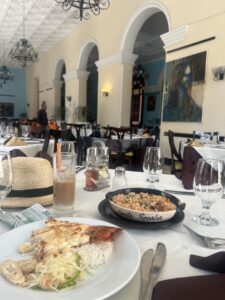 In Cuba lobster dishes are cheap and good. Prices typically range from CUP 1200 – 6.000 (USD 4 – 20). My favorite restaurant for lobster in Havana is Los Nardos opposite the Capitolio. The cheapest lobster I found was 1200 CUP in restaurant Santa Rosalia in Santa Clara (see picture).
In Cuba lobster dishes are cheap and good. Prices typically range from CUP 1200 – 6.000 (USD 4 – 20). My favorite restaurant for lobster in Havana is Los Nardos opposite the Capitolio. The cheapest lobster I found was 1200 CUP in restaurant Santa Rosalia in Santa Clara (see picture).
If you want to read my trip reports (only in Danish, sorry, but you can use google translate) and see many more photos please go HERE.
